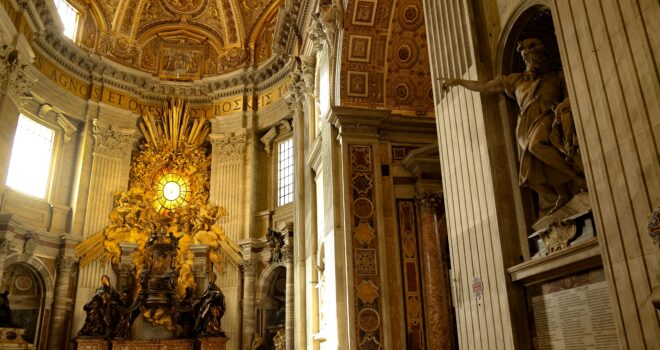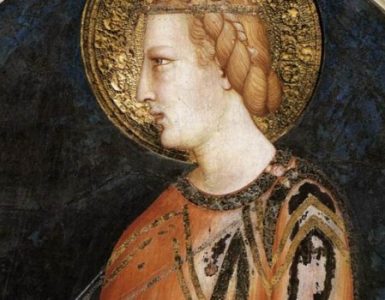I have just returned from a Select Tours Pilgrimage to some of Our Lady’s medieval shrines in Poland, Germany, Austria, and Switzerland. I don’t think I have caught my breath yet—not because of fatigue, but from gasping repeatedly at the startling beauty that blew a fuse in my heart.
These magnificent shrines were built without power tools, electricity, computer calculations, or conveniences of any kind—just artisans with their bare hands, raw talent, and passionate hearts. These artisans and artists repeated themes boldly from place to place: Jesus is here in the Blessed Sacrament, Our Blessed Mother is the Holy Mother of God who will help you, Heaven is real, Hell is real, saints are powerful, and angels are absolutely everywhere! You can look at this breathtaking art without reading a single word, and your soul imbibes the Faith directly.
I can hear the critical voices through the centuries, especially in modern generations, echoing the sentiments of Judas: “Why all this waste? Why wasn’t the money given to the poor?”
One response to this question comes from a surprising source: Saint Mother Teresa of Calcutta, who certainly understood the needs of the poor but also understood the extravagant love of Christ’s Eucharistic presence manifested in these churches. Decades ago, at a breakfast at the Rome novitiate of the Missionaries of Charity (yes, I was exploring my vocation, but the Lord called me elsewhere), Mother Teresa asked if we had enjoyed exploring the great churches in Rome. Someone asked her how she felt about the opulence of the buildings. Her childlike reply was that churches were built as a palace for the Divine King who dwelt there. And Jesus is not just another king; He is King of Kings and Lord of Lords. The magnificence of the churches is a tribute of faith to His Divine Presence in the Eucharist. Mother told us that the churches’ splendor was an important, faith-affirming, and beautiful way to remind people of Who it is that dwells there.
Church buildings are a testimony to the faith of the people who build them, from the richest to the poorest. They were built to inspire, uplift, and pass on the faith to the generations. The great sorrow is that through the centuries, there has been a stark loss of faith. Even with these exterior signs and wonders, the people’s hearts are becoming increasingly emptied of living faith. Some of these places have even been turned into art museums.
If the King does not reside within people’s hearts, they will not perceive His presence in the Tabernacle. The great question is how to enthrone Him in the heart of a child so that the next generation will recognize and cherish the Divine Guest in the Tabernacle as in days gone by—how to help children grasp the fact that the Divine and Risen Christ is present here, in this Catholic Church, Body, Blood, Soul, and Divinity.
Again, I have an unlikely Catholic hero when it comes to the question of how to rebuild the faith in the Church: Babe Ruth. He expressed childlike simplicity in his return to the Catholic faith of his youth. Babe was successful in the world, but he lived a rather raucous private life, which deadened (but did not destroy) his life of faith. He played and strayed his whole life. When he was dying of esophageal cancer, a young boy sent him a Miraculous Medal, promising the prayers of his entire class. Instantly, Babe’s heart became open to grace, and the avalanche of formation that he had received as a child in his Catholic school days flooded back into his heart and soul. He said, “The more I think of it, the more important I feel it is to give kids ‘the works’ as far as religion is concerned. They’ll never want to be holy—they’ll act like tough monkeys in contrast, but somewhere inside will be a solid little chapel.” When Babe Ruth died, he did so in the loving arms of the Church, in full communion, filled with peace.
The hearts of the children of this era have no chapel inside them—yet. When they enter their churches, nothing resonates. Their formation is shoddy, skimpy, erroneous, and oftentimes completely missing. Like the artisans of old, we must dig deep into the gifts that God gave each of us for this task, desiring to build that solid little chapel in the hearts of children with all our might and all our conviction. There is nothing like a good beginning! No one drives a car looking in the rearview mirror the whole time. We need to go forward with all our strength. Like the Israelites of old feeling in their bones the passion to rebuild the temple that was destroyed, we must reach deep into our faith convictions and recognize that the Church is made of living stones, and these stones have fallen apart. We must rebuild!
Step into the breach and begin in your own soul. Reset your own foundation in prayer and the sacraments if it is wobbly. Enter a trajectory of holiness that works for you. Then put your gifts and charisms in the service of rebuilding the ruins of the Church, like St. Francis of Assisi. Hear the desire of the Lord as Francis did: “Rebuild My Church in the hearts of My children; build a chapel in their hearts where I may dwell.” Even if they lose their faith when they get older, with a strong chapel in their hearts, they will have a place to return to, and their faith will live again inside of them as it did in Babe Ruth.
Become a priest, become a sister, become a parent who nurtures faith in the hearts of the little ones. Go to college and become a teacher, volunteer, work at summer camps—if there aren’t any, create one. Build a Catholic school, be a donor for a new school foundation, and skip purgatory (well, I’m not sure I can guarantee that one!). Be a grandmother who reads Catholic books to little people, start a youth group, pray, and ask Our Blessed Mother how your gifts would best serve the Church. Let’s go!
Editor’s Note: The author’s new children’s book, When Jesus Speaks, is available from Sophia Institute Press as well as from the author’s website, Susan Joy Books.
Photo by Rick Govic on Unsplash










